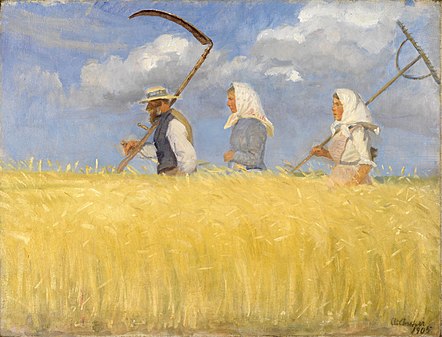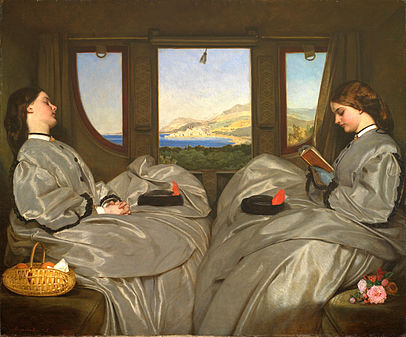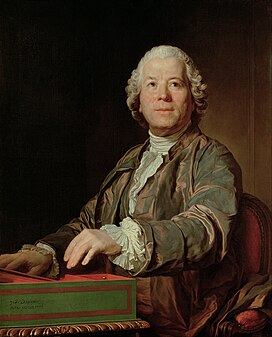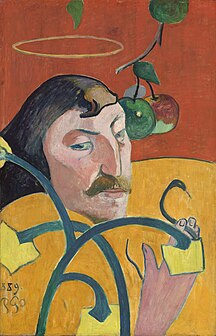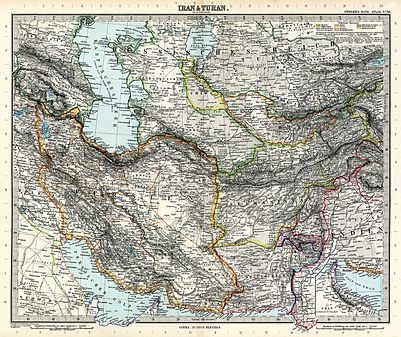Wikipedia:Wikipedia Signpost/Single/2015-09-09
Being Welsh
This is a small selection of the images held by the National Library of Wales, which holds hundreds of thousands of images documenting the people and landscapes of Wales through the ages. The National Library has adopted an open access ethos and currently employs a Wikipedian in Residence, and is now releasing some of the nation's most treasured collections to Wikimedia Commons for everyone to use and enjoy.
- Jason Evans is the Wikimedian in Residence at the National Library of Wales.
Killed by flying debris

Highlight

This week we open with an occasional piece that highlights a promoted item. The new featured article Paterson Clarence Hughes was nominated by Ian Rose, one of the three current FAC coordinators. Pat Hughes (1917–1940) was an Australian fighter ace of World War II who served with the British Royal Air Force and achieved 17 victories during the Battle of Britain before being killed in action.
The article gives a sense of a colourful and talented young man from isolated inland south-eastern Australia, a part of the continent with an unusual sub-alpine landscape he later described as magnificent and grand. His story is notable for the chasm beween this early, isolated rural life and his death in the sky on the other side of the world from debris flying out of a German bomber he had just shot down at close range—at the age of just 22 years.
The Signpost asked Ian Rose—who was on a long train trip somewhere in the northern hemisphere—whether the juxtaposition of the personal aspects and the mechanics of war has been something that attracts him to military history writing.
| “ | Absolutely. It’s the human element of warfare that attracts me to military biographies. Even when writing unit histories—such as No. 77 Squadron RAAF, or incidents like the Morotai Mutiny—I try to bring out something of the personalities involved. I’d like to share an anecdote about writing the Hughes article, because it might prove useful for other editors. I started working on improving it offline a couple of years ago, but it wasn’t quite coming together. Kristen Alexander’s recent book Australia’s Few and the Battle of Britain provided the spur to finish the article; her publication helped me to resolve a few points where the sources contradicted each other. After I updated the text, referencing Alexander, I noticed she linked the article on her blog; so I emailed her and we discussed some of the subtleties of the Hughes story, leading to further fine-tuning of the article. This was the first time I’d corresponded with the author of a key source, and it was a helpful and an enjoyable experience. Then somewhere along the way I recalled that Caesar Hull—the subject of an article by User:Cliftonian that I’d reviewed at FAC—had died the same day as Hughes during the Battle of Britain; so after Cliftonian had reviewed the Hughes FAC I suggested to him that the two aces could make a good dual TFA—and so it happened! |
” |
Featured-content managers don't often talk publicly about the forums they oversee, so we took the opportunity of asking Ian about how FAC has evolved since he became a coordinator in 2012. The most obvious change, he says, is that we no longer have an FA director, so the former FAC, FAR and TFA delegates have become coordinators. "But the director, Raul, never interfered with delegates’ decisions, and the only role I recall that he reserved for himself was that of selecting new delegates. I’ve always felt that even under him the delegates/coordinators held their positions at the pleasure of the community." Ian says that FAC nominations tend to stay open longer nowadays because there seem to be fewer reviewers around, "and we don’t like to archive noms for lack of feedback—of course that does still happen but then we leave explanations of why we’re archiving nominations more often than when I started."
Is he happy with the thematic balance of featured articles, are there any changes he’d like the community to consider making to the system?
| “ | To be honest I find Wikipedia particularly enjoyable for its more obscure articles, rather than the kind of thing I could find in "conventional" encyclopaedias—but then the stuff I write about is pretty specialised, so perhaps that’s only to be expected! As far as changes to the system go, I'd prefer to see all nominations go through peer or A-class review before FAC, but I know some articles get no feedback at PR, and my suggestion didn’t gain much traction last time I raised it. | ” |
We boldly invited him to discuss some of the more difficult decisions he's faced over the years as coordinator, but Ian was the perfect politician: "Without trying to be cagey, I honestly don’t store that much in my forebrain about past FAC decisions, but try to judge each one on its merits—and I do see a FAC coordinator as a disinterested judge—there to explain the process and to decide when consensus has been reached, but not making direct calls on the quality of articles. That’s the job of reviewers: they’re the jury."
FAC has its political dimensions: nominators work very hard and then become frustrated or hurt when their work is criticised under review. Does he have ways of distancing himself emotionally from the occasional turmoil?
| “ | As a content creator who regularly nominates at FAC myself, I really do sympathise, but as a coordinator you have to be able to distance yourself; otherwise I don’t think you could do the job properly. I’ve occasionally made decisions that have annoyed not just the nominator but some reviewers as well, but I know I’ve never taken them lightly, so I can live with them. | ” |
What are the most rewarding parts of being coordinator, then? "I enjoy working with Graham and Andy, and I like to see the give and take of a good solid review. I think the FAC process is valuable to Wikipedia, so helping to run it is very satisfying." Which leaves us with the question of what Pat Hughes would have made of all this fuss three-quarters of a century later.
Featured articles

Eight featured articles were promoted this week.
- The Battle of Malvern Hill (nominated by Ceradon and Lingzhi) (1862) was the final battle of the Seven Days Battles during the American Civil War. More than 50 thousand soldiers from each side took part, using more than 200 pieces of artillery and three warships.
- The Combat (nominated by Iridescent) Big enough to be used as a makeshift sail on a yacht, this ten foot by thirteen foot canvas by English artist William Etty shows the end of a swordfight between two warriors. The victor is about to decapitate his opponent when a near-naked woman throws herself at him, pleading for the vanquished. This is Etty’s “moral lesson”, the beauty of mercy, which he wished to be painted on the heart of the beholder. The first very large work painted by him, it was regarded during his ascendency in fashionable taste as one of his most powerful paintings. The “right foot of the female” was singled out for critical praise, although one pundit demurred, saying it "looks too much as if painted from a modern foot”.
- Kill 'Em All (nominated by Retrohead and Greg Fasolino) (1983) was the debut studio album by American heavy metal band Metallica. It was regarded as a groundbreaking album for thrash metal because of its precise musicianship, which fused a new style of British heavy-metal riffs with hardcore punk tempos.
- Kurt Vonnegut (nominated by Ceradon and Wehwalt) (1922–2007) was an American writer and humorist most famous for his darkly satirical, best-selling novel Slaughterhouse-Five (1969). His experience as a wartime POW- he was in Dresden deep underground in a meat locker while the city was destroyed in a firestorm- became the central focus of this novel, in which an unreliable narrator describes the stories of Billy Pilgrim, reluctant soldier, time traveller and exhibit in an alien zoo. As in real life, bad chemicals and bad ideas provide the motivation for many of his characters' actions. So it goes.
- Paterson Clarence Hughes (nominated by Ian Rose)
- Samuel J. Randall (nominated by Coemgenus) (1828–1890) was a Democratic member of the US House of Representatives from Pennsylvania.
- The Boat Races 2015 (nominated by The Rambling Man) were this year's side-by-side rowing race between male crews from the Universities of Oxford and Cambridge on the River Thames. For the first time in the history of the event, the men's, women's and both reserves' races were all held on the Tideway.
- United States v. Kagama (nominated by GregJackP) was a US Supreme Court case that confirmed the authority of the US Congress over Indian affairs.
Featured lists

Twelve featured lists were promoted this week.
- 78th Academy Awards (nominated by Birdienest81) – these were held March 5, 2006 in Hollywood.
- Brad Pitt filmography (nominated by FrB.TG) – it's a pretty long list.
- J. Gordon Edwards filmography (nominated by Squeamish Ossifrage) – Edwards (1867–1925) was a Canadian American film director, scenerist, and producer of the silent era.
- Katy Perry videography (nominated by FrB.TG and SNUGGUMS) – Perry, born 1984, has 33 music videos to her name.
- List of accolades received by Aadukalam (nominated by Ssven2) – Aadukalam (English: Arena) is a 2011 Tamil-language drama film directed by Vetrimaaran, which received six awards at the 58th National Film Awards.
- List of accolades received by Enthiran (nominated by Ssven2) – Enthiran was a 2010 Indian Tamil scifi film.
- List of accolades received by Gone Girl (film) (nominated by Cowlibob) Gone Girl (2014) was a psychological thriller film directed by David Fincher and starring Ben Affleck.
- List of international cricket five-wicket hauls at the Riverside Ground (nominated by The Rambling Man) – a five-wicket haul is regarded as a notable achievement.
- List of international cricket five-wicket hauls by Stuart Broad (nominated by The Rambling Man) – Broad, born 1986, is a talented and camera-favourite English cricketer.
- List of international goals scored by Wayne Rooney (nominated by The Rambling Man) – Rooney, born 1985, is a notable English association footballer.
- List of tied one-day internationals (nominated by Vensatry) – ODIs have been a high-profile form of cricket since they were developed in 1971.
- NWA World Middleweight Championship (nominated by MPJ-DK) – it's wrestling and it happened between 1939 and 2010.
Featured pictures
Twenty-eight featured pictures were promoted this week.
-
Aerial view of the Goetheanum, the world centre for the anthroposophical movement (created by Taxiarchos228; nominated by Alborzagros)
-
Portrait of Antoine-Laurent Lavoisier and his wife by David (created by Jacques-Louis David; nominated by Crisco 1492)
-
Hurricane Erika (2003) (created by NASA, MODIS/ LANCE, HDF; nominated by Crisco 1492)
-
Christoph Willibald Gluck by Duplessis (created by Joseph Siffred Duplessis; nominated by Adam Cuerden)
-
The frame of a new house under construction in Borneo (created by Cccefalon; nominated by Crisco 1492)
-
A map from Stielers Handatlas, first published in 1816 (created by Adolf Stieler; nominated by Alborzagros)
DYK, or proudly displaying incorrect information on the Main Page with alarming regularity
"Did You Know", or WP:DYK for short, is the spot on the main page below the Featured Article, where new or newly improved articles can be shown. At the moment, 16 articles are highlighted every day on the Main Page with a one-sentence hook each, which gives some 500 articles per month a short but highly visible stay in the spotlights. During the twelve hours a hook is normally on the Main Page, the MP is viewed some 5 million times, and the articles bolded in the hooks typically get a few thousand views each: the number of readers per hook will obviously be somewhere between those two figures.
DYK hooks are normally checked by at least four people before they reach the Main Page: the article nominator (often the person who created or expanded the article), the reviewer and promoter (two editors who check the article and hook on the individual DYK nomination page, transcluded on Template talk:Did you know), and the person (an administrator) who creates the DYK sections for the main page (Template:Did you know/Queue). That's four people for every hook, and at the moment 16 hooks per day. Shouldn't be too hard?
I have written a few DYKs, so I know that part of the equation. It isn't always easy to expand an article sufficiently to make it long enough for a DYK, and many articles have no interesting hooks to highlight them with. My first DYKs, back in 2007, were for Happy Hooligan and Winnie Winkle (which later became a GA as well), and more than twenty followed over the next years, on topics like Cromwell Dixon or Achilles on Skyros. I started to look more at other DYKs at the same time, and noticed some errors and problems. My first comments were in Wikipedia talk:Did you know/Archive 87#Template:Did you know nominations/Gibraltar Rock, Porongurups. Earlier archives contain many complaints from other editors about accuracy and errors. Over the next two years, I removed many hooks from the preparation area and from the main page for having (sometimes blatant) errors.
Many suggestions to improve DYK were proposed: not showing nearly every proposed article but only the best or most interesting ones, limiting the number of DYKs per person (to get more variety instead of dozens of hooks on very similar topics), adding more reviewers, banning people with many problematic (incorrect) DYKs from nominating more pages, even abolishing DYK altogether. Some things, like the suggestion that one shouldn't only look for a source confirming the hook, but also for sources contradicting the hook, were seen as a good idea, but (as the below examples will show) have not been implemented.
A few days' worth of DYK
Just look at what we have had on the Main Page over the last few days:
... that the partnership between model aircraft company Airtronics and transmitter manufacturer Sanwa helped increase the former's annual profit from less than $1 million in 1983 to $8 million in 1989?
— September 2, 12-24h, Sanwa Electronic
The article says the same, sadly the source[1] says something different: "Airtronics has 18 full-time employees and had sales of about $8 million in 1989" and "After Airtronics teamed with Sanwa, sales more than tripled – from less than $1 million in 1983 to $3 million in 1985 – and have climbed steadily since" (emphasis mine). The difference between sales and profit seems quite basic and essential ...
... that evidence of the first settlement of the Province of Pescara dates to 1500 BCE?
— September 3, 0-12h, Province of Pescara
This, like many other DYKs from this series of "Province of Italy" articles, is very dubious, and easily refuted when one looks a bit further. E.g. in Catignano (in the Province of Pescara), there lived people certainly as early as 4000 BCE[2]. It is even the namesake of a whole "culture", the Culture of Catignano, which has an article on the French Wikipedia ([3]) but isn't even mentioned in the Province of Pescara article. The idea that no people permanently lived in a fertile Italian region before 1500 BCE is highly dubious for anyone with some knowledge of the subject. But then again, on 30 August we also proudly claimed for twelve hours “that the Province of Lodi was first inhabited during the fifth century BCE” (from Template:Did you know nominations/Province of Lodi), which is equally nonsense (e.g. in Guado di Gugnano, part of Casaletto Lodigiano, bronze age remains of about 1300 BCE had already been found in the 19th century). The reason for his hook: again editors and reviewers not knowing the difference between a city and a province of the same name, apparently (source for the hook: [4] clearly discusses the origin of the city of Lodi, not the province, just like the origin of Pescara in that book is about the city, not the region ...)
The hook for the Province of Pavia in the next queue should equally be taken with a grain of salt, as that article again seems incapable of making the distinction between the current province and the ancient city of the same name. Oh, and in the very next queue, the hook about the Province of Savona (did I mention the lack of variety?): Genoa only destroyed the city once ...
... that the Syllabical and Steganographical Table was the first cryptography chart ever made?
— September 4, 12-24h, Steganographical table).
Is this claim true? Hard to tell, as no definition of what does or doesn't constitute a "cryptography chart" is given. Not surprisingly, since the only books that mention this concept are the source for the claim, and parrots of it[5]. Instead of using a lightweight "first of X" record book, an actual book on the history of cryptography may be more interesting and relevant. Something like "A Brief History of Cryptology and Cryptographic Algorithms", published by Springer[6], seems to indicate that cryptography charts have been published in the fifteenth and sixteenth centuries, so the one from the hook is not even the first published one, let alone the first ever made.
But that isn't the worst hook in that queue:
... that footballer Adam Stansfield, who died in 2010, is featured on legal tender banknotes in the English city of Exeter?
— September 4, 12-24h, Adam Stansfield)
This features a Good Article (another “quality” project on Wikipedia with many deep-rooted problems). The hook is sourced to the local Western Gazette – Yeovil [7], but the hook should have rung some alarm bells for everyone with, well, some general knowledge and a critical mind. As expected, the local banknotes issued in Exeter are not, I repeat not, legal tender, which is the exact opposite of what Wikipedia claims on the Main Page and in a Good Article ... [8], section "What can I do with Exeter Pounds", states quite clearly and unequivocally: "* Exeter Pounds are not legal tender, therefore customers do not have to accept Exeter Pounds in change."
So that's on a total of 40 "hooks", 40 sentences on the main page, at least 4 factual errors (6 if you include the Province of Pavia and Savona ones). An encyclopedia where one in ten sentences, fact-checked by at least four editors, is wrong, should not be called an encyclopedia.
Going back in time
What appeared on the main page in the hours and days before I composed this complaint (2–3 September 2015)? Well, looking at Wikipedia:Recent additions, I see that the previous Main Page DYK section informed us:
... that the capital city of the Province of Isernia was destroyed by an earthquake in 874, and its cathedral collapsed in another earthquake in 1805?
— Province of Isernia
The source for this erroneous statement gives the correct year for the earthquake, not 874 but 847, as does the article on Isernia (the city) and all other sources: no sources for 874 could be found. A simple (though quite important) typo, yes, but missed by at least four people who essentially had to check one sentence before it came on the main page.
A few days further back, we learn:
... that the Minicoy Island Lighthouse is the only lighthouse in India that has a postage stamp and a first day cover issued in its name?
— Lighthouse, Minicoy island
This will be news to e.g. Mahabalipuram lighthouse and Alappuzha lighthouse (also known as Alleppey lighthouse, should have a redirect or a move), which got a stamp and FDC in 2012[9]. Finding this takes the absolute minimum of effort: searching for India stamp lighthouse on Google[10].
I have now stayed away from Wikipedia for 8 months, not editing anything at all, for a variety of reasons. The highly unreliable information we present day in day out on our main page in the DYK section, which is not time-critical (it often takes a month between article nomination and front page appearance) and gets what should in theory be sufficient scrutiny, is probably the most visible aspect of the many failings of Wikipedia. If four people, usually all experienced editors and one of them an admin, can't get one sentence thoroughly fact-checked, then crowd-sourcing as we practice and preach it doesn't work. The system is much too reliant on individuals doing one or two critical tasks. WT:DYK has become a much quieter place since I left, not because the error rate has dropped (on the contrary), but because no one seems to really care, even though this is a significant part of the face we present to the world.
Basically, DYK is too often an endless supply of dubious "facts" to grace the Main Page, mainly created by experienced editors, always checked by experienced editors. If this is the best we can present, just imagine what nonsense gets inserted and kept day in day out in countless other articles.
- Fram has been an editor since 2005 and an administrator since 2007. Fram is the author of 20+ WP:DYK articles and was active between 2012 and 2014 on the main DYK talk page. Fram has been on a long wikibreak since late December 2014.
The Swedish Wikipedia's controversial two-millionth article
The Swedish Wikipedia hits two million articles
The Swedish Wikipedia hit two million articles this week. The Signpost was there in 2013 when the project hit one million. Both celebrations have been controversial because both the one-millionth article (Erysichton elaborata, an Australian species of butterfly) and the two-millionth article (Iro, a mountain in south Sudan) were created by Lsjbot, a bot created by Dr. Sverker Johansson (Lsj), a physicist at Dalarna University College and an administrator on the Swedish Wikipedia. A significant percentage of the articles on the Swedish Wikipedia, Cebuano Wikipedia, and Waray Wikipedia were created by the bot, which had 2.7 million articles to its credit as of last summer. Lsjbot's focus has included obscure species, such as birds and fungi, and geographical locations. The bot's work has prompted objections, especially from the German Wikipedia, that the articles are largely content-free and of little use. Proponents counter that these subjects are unlikely to receive the attention of human editors otherwise. Johansson commented on Wikipedia's articles in 2015 saying, "they're mainly written by young, white, male nerds and reflect male interests". For example, at time of writing, there do not appear to be articles on other Wikipedias about Erysichton elaborata or Mount Iro that were not created by Lsjbot. G
First bot-created article generated from Wikidata
Six Wikipedias now feature the first article created by a bot importing information from Wikidata. The article, List of paintings by Jacob van Ruisdael, was generated by ListeriaBot after an editor, Jane023, inserted Template:Wikidata list into newly created articles on each of the Wikipedias. ListeriaBot was created by Magnus Manske, who describes its use in a blog post. This approach has myriad potential uses, and promises to leverage Wikidata to make information in different language Wikipedias more consistent, current, and reliable. But it also has a few potential problems. ListeriaBot will automatically update the article but will also overwrite any changes made by human editors. Human editors, especially novice ones, may not be willing to go to the Wikidata and learn its workings in order to update a list on Wikipedia. Manske offers a common.js script that provides a popup allowing editors to update Wikidata from the Wikipedia article itself. Although this is an impressive tool for advanced editors, it is still not one likely to be employed by novice ones. G
The Orange Bar of Doom has finally met its doom
On September 10, without notice, the notification indicators at the top of every user's interface changed. The old Orange Bar of Doom was replaced with two new indicators, one for messages and one for alerts. (To the side is an image representation provided by Orange Suede Sofa). We will provide a follow-up next week with the results of our poll, including some selected comments. Users are currently giving the new feature mixed reviews in a Village Pump thread. Some users are reporting glitches, especially when using certain skins, and it is unclear when they might be fixed. T
Active editor numbers still on the rise
After several years of decline, the number of editors retaining a hundred or more live mainspace edits on the English Wikipedia was 3,458 in August. The number was up more than 11% on August 2014, and last month was the eighth month in a row to see an increase compared to the same month in the previous year (July topped the July 2013 figure as well and August is now above the August 2011 figure). This continues a trend discussed last month in the Signpost. G
Arbitrator to resign
On September 4, Euryalus announced that he would step down from the Arbitration Committee at the end of the year. He wrote, "It's been an entirely worthwhile experience, but it takes too much time away from what I enjoy a lot more, which is the writing of obscure articles on eighteenth century shipping and colonial figures. I have Wikipedia hours for either Arbcom or articles - after a year doing Arbcom I'd like to get back to the topics I left behind." Euraylus was elected in 2014 to a two-year term with 62.76% support. Early resignations from the Committee are not uncommon. G
New templates
Because of the recent Orangemoody case, a new series of paid-editing warning templates have been created by Fuhghettaboutit. {{Uw-paid1}}, {{Uw-paid2}}, {{Uw-paid3}}, and {{Uw-paid4}} have not been added to Twinkle yet and a discussion for their addition is ongoing on the Twinkle project's talk page. T
Mass media production traffic
This week's theme in popular articles revolved entirely around mass media productions, with the Straight Outta Compton docudrama feature yielding multiple top-popularity articles for the third week in a row, a new docudrama series taking the 1st and 4th places, a dead horror movie mogul in 2nd, a dead-on-arrival movie in 8th, and two new video games.
The weekly WP:TOP25 is unavailable because of questions about its exclusion list. The Galapagos shark article was excluded from the top ten because of very low reported mobile page views. However, there were reports of shark sightings and of at least one shark attack last week. The Overview effect had almost entirely mobile page views on a transient date. Please see WP:5000 for raw data.
A couple of interesting selections from the most edited articles are the European migrant crisis and anti-gay marriage county clerk Kim Davis articles.
Top ten articles by page views
| Rank | Article | Views | Class | Image | Comment |
|---|---|---|---|---|---|
| 1 | Pablo Escobar | 1,573,813 | File:Pablo Escobar graffitti.jpg | The Colombian Medellín drug cartel leader, until his law enforcement shootout death in 1993, is the subject of the recently debuted television series Narcos, listed below in 4th place. | |
| 2 | Wes Craven | 891,306 |  |
This American film director, writer, producer, and actor known for several horror movies including A Nightmare on Elm Street died of cancer at age 76 on Sunday, August 30. | |
| 3 | Eazy-E | 827,728 | N.W.A rap music performer Eric Wright, who died of AIDS in 1995, is portrayed in the recently released film Straight Outta Compton which appears below in 7th place. | ||
| 4 | Narcos | 635,565 | The Netflix show about Pablo Escobar, who tops this list, debuted on Friday, August 28 to generally favorable reviews. | ||
| 5 | Until Dawn | 631,313 | This recently released PlayStation survival horror video game features supernatural elements such as immortal souls corrupted by cannibalism. At press time it was not clear whether Sony will attempt to measure the relative extent to which customers of this game tend to avoid cannibalism. | ||
| 6 | Dr. Dre | 614,344 |  |
N.W.A rap music performer Andre Young is portrayed in the recently released film Straight Outta Compton below. | |
| 7 | Straight Outta Compton | 611,826 | This well reviewed film about hip hop group N.W.A, named after their 1988 debut studio album, was released August 14. | ||
| 8 | We Are Your Friends | 591,428 | This movie about dance club DJs recently opened to mixed reviews, following a formula and critical reception similar to that of the 1988 movie Cocktail, but resulting in one of cinema's worst opening weekends. | ||
| 9 | Ice Cube | 575,453 |  |
N.W.A rap music performer O'Shea Jackson is portrayed in the recently released film Straight Outta Compton which appears above in 7th place. | |
| 10 | Metal Gear Solid V: The Phantom Pain | 565,054 | Released Tuesday, September 1, this eleventh and final installment in the Metal Gear video game series is the fifth in its chronology, featuring combat in Afghanistan during the Soviet-Afghan War and the Angola-Zaire border region during the Angolan Civil War. |
Tech news in brief
Latest tech news from the Wikimedia technical community. Please tell other users about these changes. Not all changes will affect you. Translations are available.
Recent changes
- You can now mention up to 50 users in a post and they will get a notification. Previously you could notify up to 20 users. [11]
- A new version of the Wikidata Toolkit has been released. It now has Wikibase API support. [12]
- You can now use Wikidata to find all good or featured articles in a Wikipedia version. [13]
Problems
- There was a problem with Tool Labs due to kernel issues. This has been fixed. [14]
- The Content Translation tool published some pages with the same reference repeated several times. This has been fixed. [15][16]
Changes this week
- The new version of MediaWiki will be on test wikis and MediaWiki.org from September 8. It will be on non-Wikipedia wikis from September 9. It will be on all Wikipedias from September 10 (calendar).
- The maximum character length when you search for something on the Wikimedia wikis is now 300 characters. [17]
- The notifications list has been split into two lists. As a first step, notifications about messages on your user talk page will be placed in the second list. Feedback is requested at the Echo talk page. [18][19]
Meetings
- You can join the next meeting with the VisualEditor team. During the meeting, you can tell developers which bugs are the most important. The meeting will be on September 8 at 19:00 (UTC). See how to join.
- You can join the Wikitech ambassadors mailing list. The list is for Wikimedians interested in spreading information about Wikimedia technology news. See how to join.
Future changes
- The Wikimedia mailing lists will be moved to a new server and the software will be upgraded. This will happen on September 9 at 14:00 (UTC). The mailing lists will not be working during the move. It can take up to four hours. [20]
- Wikidata will soon be able to store measurements, such as a mountain's height or the distance between two places. [21][22]
Tech news prepared by tech ambassadors and posted by bot • Contribute • Translate • Get help • Give feedback • Subscribe or unsubscribe.
Calling all scientists!; More Wikipedia editors in the Netherlands than all of Africa combined
Calling all scientists!
Nature covers the recent Wikipedia Science Conference in London, part of Wikipedia's outreach to scientists and efforts to "bridge the gap between the online encyclopaedia and the research community".
Discussing the reasons why such outreach is necessary, Martin Poulter, an organizer of the conference, told Nature:
| “ | A lot of academics have the impression that because anyone can edit, that means it’s a Wild West. But Wikipedia is a community of ultra-pedants who care about facts being right. | ” |
Poulter added that there was a "cultural barrier" militating against stronger involvement from scientists, who may feel they have too little time to get into the lengthy discussions that sometimes occur around Wikipedia edits. Poulter said, "There have to be changes from both sides. That’s what we’re discussing."
The conference, which took place September 2–3, brought Wikipedians together with academics and publishers new to Wikipedia editing. (Sept. 7) T
More Wikipedia editors in the Netherlands than all of Africa combined
Vice reports on a paper published by researchers at the Oxford Internet Institute (OII) which comes to the conclusion that "the relative democratisation of the Internet has not brought about a concurrent democratisation of voice and participation".
| “ | We wanted to look at issues of participation in Wikipedia and look at who gets to represent who. [...] We wanted to see if Wikipedia offered a space, not just for people in the UK to write about things in the UK, but for, say, people in Kenya to write about things in Kenya. | ” |
By geolocating both edits and editors across the various language versions of Wikipedia, the researchers found that editors from North America played a disproportionate role in creating both Wikipedia content about their own culture and content about other cultures. Five countries – the US, the UK, Germany, France and Italy – were responsible for 45 percent of all Wikipedia edits, and there were "more Wikipedia editors from The Netherlands than all of Africa combined". And when editors from low-income countries did participate, they tended to write about global rather than local topics.
Mark Graham, an associate professor at the OII and one of the authors of the paper, suggested that despite awareness of this issue within Wikipedia and laudable efforts such as the global outreach team, Wikipedia "is not inherently democratising knowledge" – its own rules reinforce rather than subvert the status quo:
| “ | You need content to make more content on Wikipedia; you can’t just submit content without any citation. If you are trying to contribute content about a place where there is little existing content about it in the first place, you’re going to have a hard time finding sources to back up what you’re trying to say. [...] I think the reason why we see Western Europe and North America dominating at Wikipedia is not necessarily because they’re better at it, but because they have all of these underlying institutional advantages that Wikipedia is just reflecting, rather than undermining in any way. |
” |
Remedial efforts therefore needed to focus on the development of cultural and educational infrastructure in the countries concerned, Graham argued; internet technology alone was no quick fix in levelling the playing field. (Sept. 8) AK
In brief
- Wikipedia can be used to detect search trend data: The Stack recently reported a new Japanese study. The study shows an example where a page view statistics graph of the Anne Hathaway article on Wikipedia will closely mimic a Google Trends graph of searching "Anne Hathaway" on Google. It was decided that this method can be used to estimate search statistics for less popular subjects not covered by Google Trends. (Sept. 9) T
- Koch Brothers: The Daily Kos claims to have found evidence of a "multi-year Wikipedia whitewashing" campaign focused on articles related to Koch Industries and Charles Koch. The article refers to a discussion thread at the administrators' incidents noticeboard in which the complainant, apparently a Daily Kos journalist working undercover, was eventually blocked. (Sept. 9) AK
- Politics and religion: The New York Observer was the latest publication to do a round-up of the most edited Wikipedia pages. (Sept. 8) AK
- Labor of love: Vice has an in-depth examination of the history of Wikipedia's Labor Day article. (Sept. 8) AK
- Embattled President: In Slate, University of Iowa Professor Kembrew McLeod writes about the embattled incoming UI President Bruce Harreld, who has come under fire for his error-filled resume and complete lack of higher education experience. At an introductory talk and Q&A, which McLeod posted on YouTube in the category "comedy", Harreld had a contentious discussion with one UI alum. The conflict was regarding his earlier statement that UI was not a "Public Ivy", information he said he got from Wikipedia, though the Wikipedia article on the university correctly identifies it as a Public Ivy. (Sept. 8) G
- The Tamil Wikipedia sets a goal for 100k articles: The Hindu reports on the efforts to recruit editors to work on the Tamil Wikipedia. The Times of India also reports that the Tamil Wikipedia has set a goal to reach one hundred thousand articles over the next year. As of writing this, the Tamil Wikipedia has over 69 thousand articles. (Sept. 7) G
- Harvard students host an edit-a-thon: On September 7th, a group of eight Harvard undergrads assembled an edit-a-thon to improve and create feminist articles on Wikipedia. The Harvard student newspaper, The Harvard Crimson, reported on the event. (Sept. 7) T
- Wikipedia founder backs site's systems after extortion scam: The Guardian interviewed Jimmy Wales on last week's revelation of the Orangemoody paid editing extortion ring. Wales said:
| “ | It was the result of an investigation into some suspicious behaviour uncovered by the community, which was followed up on to figure out what was going on. And we solved the problem by banning this cluster of accounts. For us, it’s a validation of how we do things: how it’s supposed to work. | ” |
- (Sept. 6) G
- Mayoral plagiarism: MedioTiempo reports that former football star Cuauhtémoc Blanco plagiarized entire sections of the article about him on the Spanish Wikipedia in his registration paperwork for the mayoral race in Cuernavaca, the capital of Morelos, Mexico. Blanco won the June 7 election and will assume office on January 1. (Sept. 6) G
- Bandits: The Daily Beast reports on how Cuban pianist Dayramir González was "Shaken Down by Wikipedia’s Blackmail Bandits". González was one of the victims of the Orangemoody scam. The Beast notes that his "story is special among most of the other targets because he meets Wikipedia’s standards for notability". The article concerning him was deleted. (Sept. 5) G
- Who will save your soul?: In the Financial Times, Murad Ahmed writes about "Wikipedia’s struggle to save its soul" in the wake of the recent revelations of paid editing like the Orangemoody ring and the Sunshine Sachs controversy as well as the declining numbers of active editors. Ahmed concludes:
| “ | without its fact-checkers, faith in Wikipedia’s information will fade. Its survival depends on people keen to continue to contribute freely to the sum of human knowledge. The fear is the motivations of those with money will outlast the interest of editors without it. Self-serving changes to the pages of billionaires, companies or talent show contestants go unnoticed — and so, for many, become truth. Without reinforcements, the bright line cannot hold for ever. | ” |
- (Sept. 4) G
- Jimmy Wales on China's block of Wikipedia: GreatFire, a non-profit organization monitoring internet censorship in China, interviewed Jimmy Wales. The Chinese Wikipedia has been blocked in China since May. Wales said:
| “ | I think our approach has been better than anyone's ... I am most proud that we have always been 100% uncompromising, and better than any other major website on these issues. | ” |
- (Sept. 4) G
- Critical eye: In The Conversation, academic Taha Yasseri, a former checkuser in the Persian Wikipedia, argues that "using Wikipedia as PR is a problem, but our lack of a critical eye is worse". He stated:
| “ | Our own research has shown that scholars with Wikipedia articles have no greater statistically significant scientific impact than those without. So why do some appear on Wikipedia while others do not? The reason is clear: because many of those entries are written by themselves or their students or colleagues. It’s important that this aspect of Wikipedia should be communicated to those reading it, and remembered every single time you’re using it. | ” |
- (Sept. 4) AK
- Is the Google Knowledge Graph killing Wikipedia?: In Forbes, Jayson DeMers wonders if the Google Knowledge Graph is killing Wikipedia. The drop in traffic that Google directs towards Wikipedia may be a result of the Knowledge Graph answering many basic queries. (Sept. 4) G
- Stay positive: The Associated Press reports on a new study published in PLOS One called "Editorial Bias in Crowd-Sourced Political Information", by Joshua L. Kalla of University of California, Berkeley and Peter M. Aronow of Yale University. Prior to the 2014 US Senate elections, the authors added positive and negative accurate facts to Wikipedia articles of sitting US Senators. Their study found that "Negative facts are 36% more likely to be removed by Wikipedia editors than positive facts within 12 hours and 29% more likely within 3 days." They also found that the bias towards positivity was solely for incumbents. When replicating the experiment for the articles of retired and deceased Senators, they found that the reaction to the edits was not similarly skewed. (Sept. 3) G
- Industrial-scale blackmail: The Register describes the Orangemoody case as "Wikipedia’s biggest scandal" and attributes the problem to Wikipedia's overriding commitment to anonymity:
| “ | Wikipedia appears to be a miracle of collaboration – but without the right kind of governance structures, it was always ripe for gaming. There’s no reason a collaborative project should inevitably be gamed, if the necessary checks and procedures to prevent it are in place. But this is Wikipedia’s biggest problem: it prefers protecting its contributors above any other ethical concern. Given the choice between doing the right thing (producing a better Wikipedia) and protecting anonymity, the Wikipedia community has chosen anonymity every time. | ” |
- (Sept. 3) AK





































